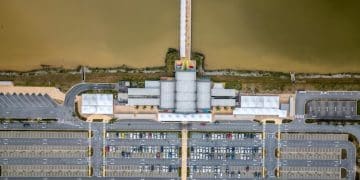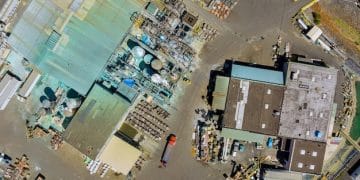Mexico’s Manufacturing Sector: Nearshoring Benefits for US Companies

Mexico’s manufacturing sector offers significant nearshoring advantages for US companies through cost reductions, supply chain resilience, and preferential trade agreements, fostering enhanced North American competitiveness.
In a dynamic global economy, the strategic repositioning of supply chains has become a paramount concern for businesses. This article delves into Mexico’s manufacturing sector: how can US companies benefit from nearshoring? We will explore the multifaceted advantages and analyze the evolving landscape that makes Mexico an increasingly attractive destination for American enterprises.
The Shifting Global Landscape and the Rise of Nearshoring
The past decade has witnessed unprecedented disruptions to global supply chains, from geopolitical tensions to a pandemic that exposed vulnerabilities in distant manufacturing hubs. These challenges have compelled businesses to reassess their operational strategies, leading to a significant pivot towards nearshoring, particularly for US companies looking southward to Mexico.
Nearshoring is not merely a trend; it represents a strategic imperative aimed at enhancing resilience, reducing lead times, and regaining control over complex logistical networks. Mexico, sharing a vast border with the United States, naturally emerges as a prime candidate for this strategic relocation of manufacturing operations.
Understanding the Nearshoring Imperative
The decision to nearshore is often a response to a confluence of factors that have made traditional offshoring models less viable or riskier. Cost savings, once the primary driver for manufacturing in distant lands, are now being weighed against the hidden costs of extended supply chains and unforeseen disruptions.
- Supply Chain Resilience: Reducing geographic distance mitigates risks associated with long transportation routes and geopolitical instabilities.
- Lead Time Compression: Shorter distances equate to faster delivery times, crucial for industries with high demand volatility or short product lifecycles.
- Improved Quality Control: Proximity allows for more frequent oversight and quicker responses to manufacturing issues.
- Cultural and Time Zone Alignment: Similar working hours and cultural understanding can streamline communication and collaboration.
The appeal of nearshoring to Mexico is further amplified by its established industrial infrastructure and a workforce increasingly skilled in various manufacturing processes. This combination creates a compelling argument for US companies seeking to optimize their production methods without sacrificing efficiency or quality.
As global trade dynamics continue to evolve, the advantages offered by Mexico’s manufacturing sector are becoming more apparent, attracting substantial interest from a diverse range of US industries. The shift represents a fundamental re-evaluation of global production strategies, with Mexico at the forefront of this transformation.
Economic Advantages and Cost Efficiencies in Mexico
One of the most compelling reasons for US companies to consider nearshoring to Mexico lies in the significant economic advantages and cost efficiencies it offers. While labor costs are often cited, the benefits extend much further, encompassing operational expenses, logistical savings, and favorable trade agreements.
Mexican labor, while subject to ongoing wage increases, remains significantly more competitive than in the United States. This difference translates into substantial savings on direct labor costs, a critical component for many manufacturing processes. Furthermore, the productivity of the Mexican workforce has been steadily rising, enhancing the overall value proposition.
Labor Cost Competitiveness
The average manufacturing wage in Mexico is considerably lower than in the US, providing a direct cost advantage. This wage differential allows US companies to produce goods at a lower unit cost, improving profitability and competitiveness in the market.
- Lower average hourly wages for skilled and unskilled labor.
- Reduced overhead costs related to benefits and social security contributions compared to the US.
- A growing pipeline of technical and engineering talent from Mexican universities and vocational schools.
Beyond direct wages, the overall cost of doing business in Mexico can be more favorable. Real estate for industrial facilities, utilities, and certain raw materials or components can often be sourced at lower prices, further contributing to cost efficiencies.
The operational savings realized through nearshoring to Mexico are not limited to production; they also extend to logistics and inventory management. Shorter supply lines mean less capital tied up in transit and reduced warehousing costs, leading to a more agile and lean operational model. These combined economic advantages make Mexico an attractive proposition for revitalizing manufacturing profitability.

Trade Agreements and Preferential Treatment
The North American Free Trade Agreement (NAFTA), now replaced by the United States-Mexico-Canada Agreement (USMCA), has historically been a cornerstone of the robust trade relationship between the US and Mexico. These agreements provide a framework that significantly benefits US companies engaged in nearshoring activities.
The USMCA ensures duty-free access for most goods manufactured in Mexico that meet the rules of origin criteria, eliminating tariffs that would otherwise increase the cost of imported products. This preferential treatment makes Mexican-produced goods highly competitive when entering the US market, directly benefiting American consumers and businesses.
Key Provisions of USMCA
The USMCA builds upon NAFTA, modernizing certain provisions and introducing new ones to reflect the contemporary economic landscape. Its core principles continue to facilitate seamless trade within North America, offering stability and predictability for investors.
- Rules of Origin: Stricter requirements ensure that a higher percentage of content originates within North America, encouraging regional supply chains.
- Labor Provisions: Enhanced labor protections and higher wage requirements in certain sectors, aiming for fairer competition.
- Digital Trade: Modern provisions addressing e-commerce and digital services, essential for contemporary business operations.
Beyond USMCA, Mexico has a vast network of free trade agreements with numerous countries globally, providing US companies with a strategic export platform. Manufacturing in Mexico not only grants access to the lucrative US market but also opens doors to other major economies in Latin America, Europe, and Asia, diversifying market reach and reducing reliance on single markets.
The stability and long-term commitment embedded in these trade agreements reduce uncertainty for investors, making Mexico a reliable partner for manufacturing investments. This established legal and economic framework provides a strong foundation for US companies to build and expand their nearshoring operations, confident in the predictability of trade rules and market access.
Infrastructure and Logistics: Bridging the Divide
The efficiency of a manufacturing operation is heavily reliant on the quality of its infrastructure and logistical networks. Mexico has made significant investments in these areas, understanding their critical role in attracting foreign direct investment, particularly from the United States.
The proximity to the US border is Mexico’s most obvious logistical advantage. This shared border facilitates efficient cross-border transportation via an extensive network of roads, railways, and bridges. Major industrial corridors have developed along the border, specifically designed to support the flow of goods and components between the two nations.
Transportation Networks
Mexico’s commitment to improving its transportation infrastructure is evident in its modern highways and railway systems, which connect industrial zones to ports and border crossings. This enhances the speed and reliability of freight movement, reducing transit times and logistical costs for US companies.
- Road Networks: Well-maintained highways connecting major cities and industrial hubs directly to US border crossings.
- Railways: Extensive freight rail lines offering a cost-effective and environmentally friendly option for bulk cargo transport.
- Seaports: Modernized ports on both the Pacific and Atlantic coasts providing global shipping access.
- Airports: Numerous international airports facilitating air cargo for high-value or time-sensitive goods.
In addition to physical infrastructure, the development of robust logistics services within Mexico has been crucial. A strong ecosystem of third-party logistics (3PL) providers, customs brokers, and warehousing facilities ensures that supply chain operations run smoothly. Many of these providers specialize in cross-border trade, offering expertise in navigating the complexities of international shipping and customs procedures.
The continuous investment in logistics and infrastructure strengthens Mexico’s position as a reliable nearshoring destination. US companies can leverage these established networks to optimize their supply chains, ensuring timely delivery of components and finished goods while minimizing transit-related risks and costs.
Skilled Workforce and Growing Talent Pool
Beyond cost advantages, the availability of a skilled and adaptable workforce is a critical factor for manufacturing success. Mexico has been proactively investing in education and vocational training programs to cultivate a talent pool that meets the demands of modern manufacturing, creating a significant asset for US companies.
The country boasts a young and growing population, with a strong emphasis on technical education. Many universities and technical institutes offer specialized programs in engineering, mechatronics, and advanced manufacturing, producing graduates ready to enter the industrial sector. This focus on practical skills ensures a steady supply of capable workers for various manufacturing roles, from assembly line operators to advanced engineers.
Developing Specialized Skills
The Mexican workforce has demonstrated a strong capacity for learning and adapting to new technologies and processes. Many international companies report high levels of productivity and quality from their Mexican operations, reflecting the dedication and aptitude of the local labor force.
- Vocational Training: Government-supported and private vocational schools provide hands-on training in specific manufacturing disciplines.
- Bilingual Talent: A growing number of professionals and workers possess English language skills, facilitating communication and collaboration with US counterparts.
- Engineering Graduates: Mexico produces a significant number of engineers annually, many with expertise in automotive, aerospace, and electronics manufacturing.
Furthermore, the cultural proximity between Mexico and the United States often leads to easier integration of management and operational teams. Similar work ethics and a shared understanding of business practices can accelerate the learning curve and enhance overall efficiency within nearshored facilities.
The development of a robust and skilled workforce is not just about numbers; it’s about quality and adaptability. Mexico’s commitment to nurturing its human capital ensures that US companies can find the talent necessary to operate sophisticated manufacturing processes, making it a compelling destination for long-term investment in production capabilities.

Addressing Challenges and Future Outlook
While the advantages of nearshoring to Mexico are compelling, it’s essential for US companies to acknowledge and prepare for potential challenges. Like any foreign investment, operating in Mexico comes with its own set of considerations, ranging from regulatory complexities to security concerns.
Navigating the Mexican legal and regulatory framework requires careful planning and often local expertise. Permitting processes, labor laws, and intellectual property rights must be thoroughly understood and complied with to ensure smooth operations. Engaging experienced local counsel and consultants can mitigate these risks.
Overcoming Potential Hurdles
Addressing potential challenges proactively is key to a successful nearshoring strategy. While headlines may sometimes highlight issues, many large corporations have successfully operated in Mexico for decades by implementing robust risk management strategies.
- Regulatory Compliance: Understanding and adhering to local laws, tax codes, and environmental regulations.
- Security Concerns: Implementing comprehensive security protocols for personnel, facilities, and supply chains.
- Infrastructure Bottlenecks: Identifying and addressing potential limitations in utility supply or transportation in specific regions.
- Cultural Adaptations: Training and sensitizing management to local customs and communication styles.
Despite these challenges, the overall outlook for Mexico’s manufacturing sector and its role in North American supply chains remains incredibly positive. The strong political and economic ties between the US and Mexico, reinforced by USMCA, create a stable environment for continued growth and investment.
The ongoing commitment by both governments to enhance trade facilitation and cross-border infrastructure further solidifies Mexico’s position as a preferred nearshoring destination. As global supply chains continue to evolve, Mexico is poised to play an even more strategic role in ensuring the resilience and competitiveness of North American industries.
| Key Aspect | Benefit for US Companies |
|---|---|
| 📊 Cost Efficiency | Significant savings on labor, operational, and logistical expenses compared to overseas production. |
| 🤝 USMCA Trade Agreement | Duty-free access to the US market and stable trade relations, reducing tariff risks. |
| 🚚 Proximity & Logistics | Reduced lead times, improved supply chain resilience, and efficient cross-border transportation. |
| 🎓 Skilled Workforce | Access to a large, young, and increasingly skilled labor force, including engineers and technical staff. |
Frequently Asked Questions about Nearshoring to Mexico
▼
Nearshoring involves relocating business operations to a nearby country rather than a distant one. Mexico is a prime destination due to its proximity to the US, lower labor costs, robust trade agreements like USMCA, and a well-developed manufacturing infrastructure, allowing for faster response times and reduced supply chain risks.
▼
The USMCA (United States-Mexico-Canada Agreement) provides significant benefits by ensuring duty-free access for most goods manufactured in Mexico that meet the strict rules of origin criteria. This eliminates tariffs, making products more cost-effective when imported into the US, and offers a stable and predictable trade environment for investments.
▼
US companies can realize substantial cost advantages through lower average labor wages, reduced operational expenses such as real estate and utilities, and significant logistical savings due to shorter transportation routes. These combined factors contribute to a more competitive cost structure for manufactured goods.
▼
Yes, Mexico has been actively investing in education and vocational training. The country produces a large number of engineering and technical graduates annually, particularly in fields relevant to automotive, aerospace, and electronics manufacturing. This results in a skilled and adaptable workforce capable of handling advanced production processes effectively.
▼
Companies should be prepared to navigate regulatory complexities, including local laws and permitting processes. While improving, infrastructure in some regions may still pose challenges, and security considerations must be fully addressed through robust risk management. Cultural differences also require careful attention for effective management integration.
Conclusion
The decision to relocate manufacturing operations is complex, yet for many US companies, the compelling advantages offered by Mexico’s manufacturing sector present a clear and strategic path forward. From significant cost efficiencies and preferential trade agreements under USMCA to a robust infrastructure and a growing pool of skilled labor, Mexico positions itself as a powerhouse for nearshoring. While challenges exist, they are often manageable with diligent planning and expert guidance. By leveraging Mexico’s competitive landscape, US companies can build more resilient, agile, and cost-effective supply chains, ultimately enhancing their global competitiveness and securing a stronger future in the evolving landscape of international trade and production.





